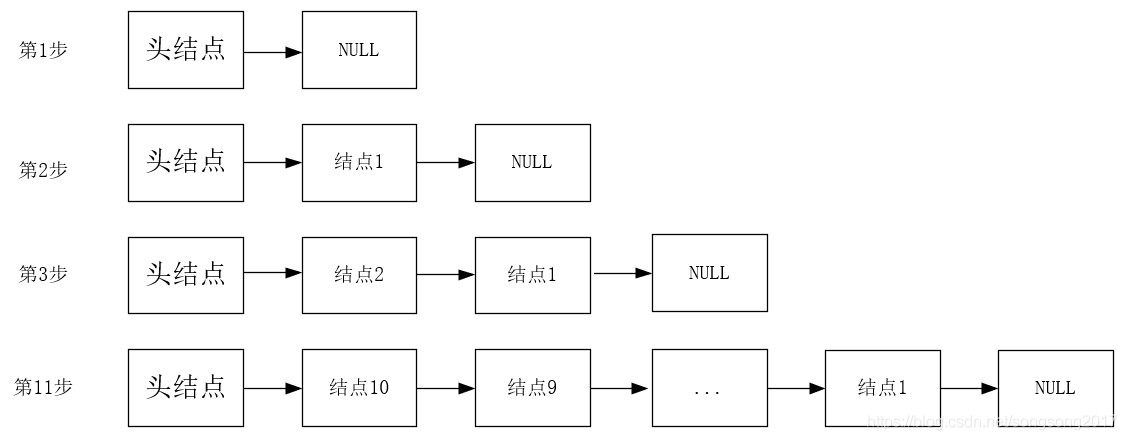前言
在学链表的时候,对链表创建的过程一知半解。目前现在刷题的阶段,发现这部分很重要,所以这次完全解决这个知识点。
1 带头结点的链表
为了方便,创建带有10个结点的链表,链表的数据域为整数类型,取随机整数。链表结构如下图:

1.1 头插法
头插法的思想如下图:

伪代码实现:
(1)创建一个头结点,ListNode *head = new ListNode(10) ; //头结点数据域保存结点的个数
head -> next = nullptr;
(2)插入结点1,LIstNode *s = new ListNode(rand()); // 创建结点1
s – > next = head -> next;
head -> next = s;
(3)插入结点2,LIstNode *s = new ListNode(rand()); // 创建结点2
s – > next = head -> next; // 这里 head – > next 其实就是结点1
head -> next = s;
(4)重复上述流程,创建完成
1.2 头插法代码实现
struct ListNode{
int val;
ListNode *next;
ListNode(int x) : val(x), next(nullptr){
}
}
// 头插法
ListNode* CreateList(int length){
if (length < 1)
return nullptr;
ListNode *head = new ListNode(length);
head -> next = nullptr;
int k = 1;
ListNode *s = nullptr;
srand(unsigned(time(0)));
while (k <= length){
s = new ListNode(rand());
s -> next = head -> next;
head -> next = s;
k++;
}
return head;
}
1.3 尾插法
尾插法的思想如下图:

伪代码实现:
(1)创建一个头结点,ListNode *head = new ListNode(10) ; //头结点数据域保存结点的个数
ListNode *s = head;
(2)插入结点1,LIstNode *r = new ListNode(rand()); // 创建结点1
s -> next = r;
s = r;
(3)插入结点2,LIstNode *r = new ListNode(rand()); // 创建结点2
s – > next = r;
s = r;
(4)重复上述流程,最后时,让s -> next = nullptr,返回head。
1.4 尾插法代码实现
struct ListNode{
int val;
ListNode *next;
ListNode(int x) : val(x), next(nullptr){
}
}
// 尾差法
ListNode* CreateList(int length){
if (length < 1)
return nullptr;
ListNode *head = new ListNode(length);
ListNode *s = head;
int k = 1;
ListNode *r = nullptr;
srand(unsigned(time(0)));
while (k <= length){
r = new ListNode(rand());
s -> next = r;
s = r;
k++;
}
s -> next = nullptr;
return head;
}
2 无头结点的链表
为了方便,创建带有10个结点的链表,链表的数据域为整数类型,取随机整数。链表结构如下图:

2.1 头插法
头插法思路如下:

伪代码实现:
(1)创建结点1,ListNode *head = new ListNode(10) ; //头结点数据域保存结点的个数
head -> next = nullptr;
ListNode *s = nullptr;
(2)插入结点2,LIstNode *s = new ListNode(rand()); // 创建结点1
s -> next = head;
head = s;
(3)插入结点3,LIstNode *s = new ListNode(rand()); // 创建结点2
s -> next = head;
head = s;
(4)重复上述流程,创建完成
2.2 头插法代码实现
struct ListNode{
int val;
ListNode *next;
ListNode(int x) : val(x), next(nullptr){
}
}
// 头插法
ListNode* CreateList(int length){
if (length < 1)
return nullptr;
srand(unsigned(time(0)));
ListNode *head = new ListNode(rand());
head -> next = nullptr;
ListNode *s = nullptr;
int k = 1;
while (k <= length - 1){
s = new ListNode(rand());
s -> next = head;
head = s;
k++
}
return head;
}
2.3 尾插法
尾插法思路如下:

伪代码实现:
(1)创建结点1,ListNode *head = new ListNode(10) ; //头结点数据域保存结点的个数
ListNode *s = head;
(2)插入结点2,LIstNode *r = new ListNode(rand()); // 创建结点1
s -> next = r;
s = r;
(3)插入结点3,LIstNode *r = new ListNode(rand()); // 创建结点2
s -> next = r;
s = r;
(4)重复上述流程,最后时,让s -> next = nullptr,返回head。
2.4 尾插法代码实现
struct ListNode{
int val;
ListNode *next;
ListNode(int x) : val(x), next(nullptr){
}
}
// 头插法
ListNode* CreateList(int length){
if (length < 1)
return nullptr;
srand(unsigned(time(0)));
ListNode *head = new ListNode(rand());
ListNode *s = head, *r = nullptr;
int k = 1;
while (k <= length - 1){
r = new ListNode(rand());
s -> next = r;
s = r;
k++
}
s -> next = nullptr;
return head;
}
// 将头结点放在循环里面
ListNode* CreateList(int length){
if (length < 1)
return nullptr;
srand(unsigned(time(0)));
ListNode *head = nullptr, *s = nullptr, *r = nullptr;
int k = 1;
while (k <= length){
r = new ListNode(rand());
if (head == nullptr)
head = r;
else
s -> next = r;
s = r;
k++
}
s -> next = nullptr;
return head;
}

 菜鸟笔记
菜鸟笔记